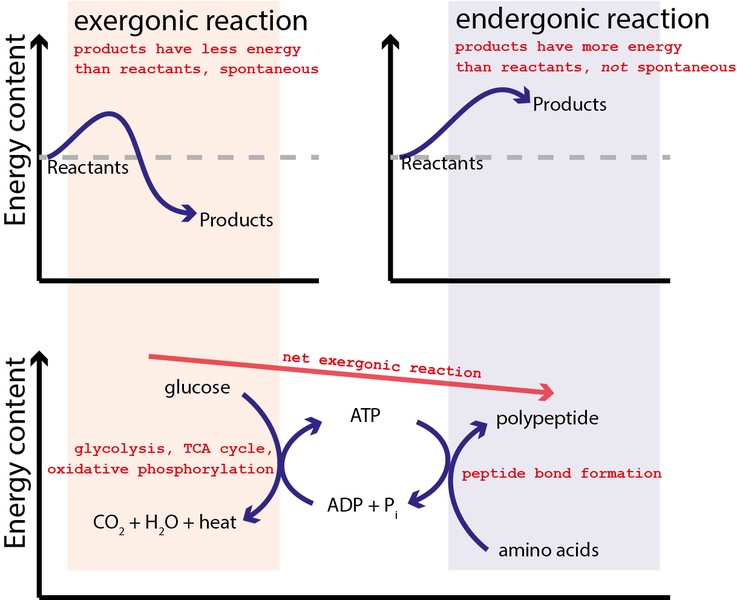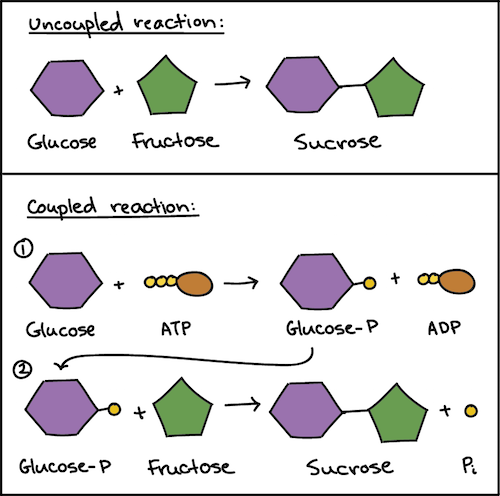Coupling Endergonic and Exergonic Reactions
An exergonic reaction is one in which the energy level of the products. The key to coupling exergonic and endergonic reactions is the formation of this phosphorylated intermediate which is more reactive less stable.
The cellular processes of energy intake and output are called endergonic or exergonic.

. One example of an exergonic reaction is cellular respiration in both plants and animals. All of the choices are correct. The formation and hydrolysis of ATP constitute what might be called an energ y-coupling cycle in which ADP picks up energy from exergonic reactions to become ATP which then donates energy to endergonic reactions.
Used to drive an endergonic reaction. In this lab you will create an endothermic and an exothermic reaction. In cells what is usually the immediate source of energy for an endergonic reaction.
The key to coupling exergonic and endergonic reactions is the formation of this phosphorylated intermediate which is more reactive less stable. An exergonic reaction is one in which the energy level of the products is lower than the energy level of the reactants a spontaneous reaction. Enzymes can couple exergonic reactions with endergonic reactions to result in a coupled reaction that is exergonic overall.
An exergonic reaction is one in which the energy level of the products. In exergonic reaction the free energy of the products is lower than that of. Energy coupling of endergonic and exergonic reactions result in an overall.
Used to decrease the entropy of the universe. The only way that an endergonic reaction can occur spontaneously is if it is coupled with an even more exergonic reaction. The reason you cant have a net ΔG 0 is because endergonic and exergonic reactions are two different types of reactions.
AC X BD. What is the fate of the phosphate group that is removed when ATP is converted to ADP. As such it is not possible for the two to cancel each other out and have a net ΔG of 0.
An intermediate that takes part in both reactions. Used to drive another exergonic reaction. The energy for an endergonic reaction comes from a n _____ reaction.
ATP is the common component of these reactions and is the agent of coupling as illustrated in Figure 86. Coupling exergonic reactions to endergonic reactions A cell does three main kinds of work. Energy coupling of endergonic and exergonic reactions result in an overall from BIO BIO-120 at Grand Valley State University.
The coupling discussed above can take place by. Endergonic reactions are those that require energy to proceed while exergonic reactions release energy. Energy coupling of endergonic and exergonic reactions.
Coupling occurs when the energy released by an exergonic reaction is. An endergonic reaction occurs by coupling with an even more exergonic. Chemical Transport Mechanical To do work cells manage energy resources by energy coupling the use of an exergonic process to drive an endergonic one Most energy coupling in cells is mediated by ATP.
Energy coupling of endergonic and exergonic reactions within cells permits biological reactions to proceed at temperatures consistent with life uses heat released by one reaction to fuel the other reaction and utilizes ATP to carry energy between the exergonic and endergonic reactions. Energy coupling is the cells ability to use the energy released from exergonic reactions is to drive endergonic reactions. Exothermic reaction When energy is released in a chemical reaction it is called an exergonic reaction.
The ATP molecule is the key to energy coupling. An endergonic reaction occurs by coupling with an even more exergonic reaction. Hence endergonic reactions occur by coupling with exergonic reactions.
Enzymes can couple exergonic reactions with endergonic reactions to result in a coupled reaction that is exergonic overall. Ad Over 27000 video lessons and other resources youre guaranteed to find what you need. The key to coupling exergonic and endergonic reactions is the formation of this phosphorylated intermediate which is more reactive less stable than the original unphosphorylated molecule.
Enzymes can couple exergonic reactions with endergonic reactions to result in a coupled reaction that is exergonic overall. Exergonic and endergonic reactions result in changes in Gibbs free energy. Lost as nonusable heat to the environment.
An exergonic reaction is one in which ΔG increases and an endergonic process is one in which ΔG decreases. Energy coupling of endergonic and exergonic reactions within cells Select one a from BIOLOGY 102 at Roxbury Community College. The reaction ADP P -- ATP is a n _____ reaction.

9 6 Coupled Reactions Chemistry Libretexts

Endergonic And Exergonic Reactions Feedback Inhibition Youtube

Atp Cycle And Reaction Coupling Energy Article Khan Academy


0 Response to "Coupling Endergonic and Exergonic Reactions"
Post a Comment